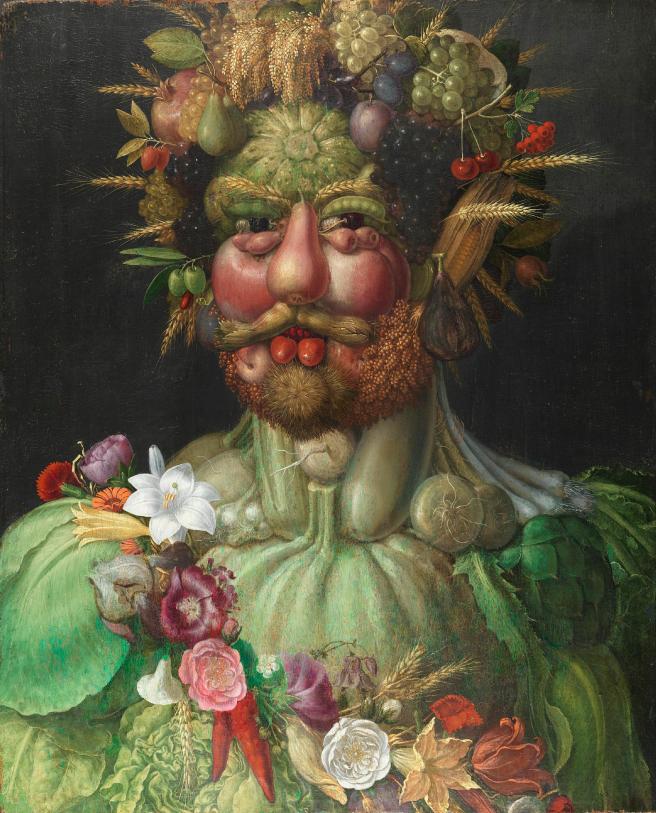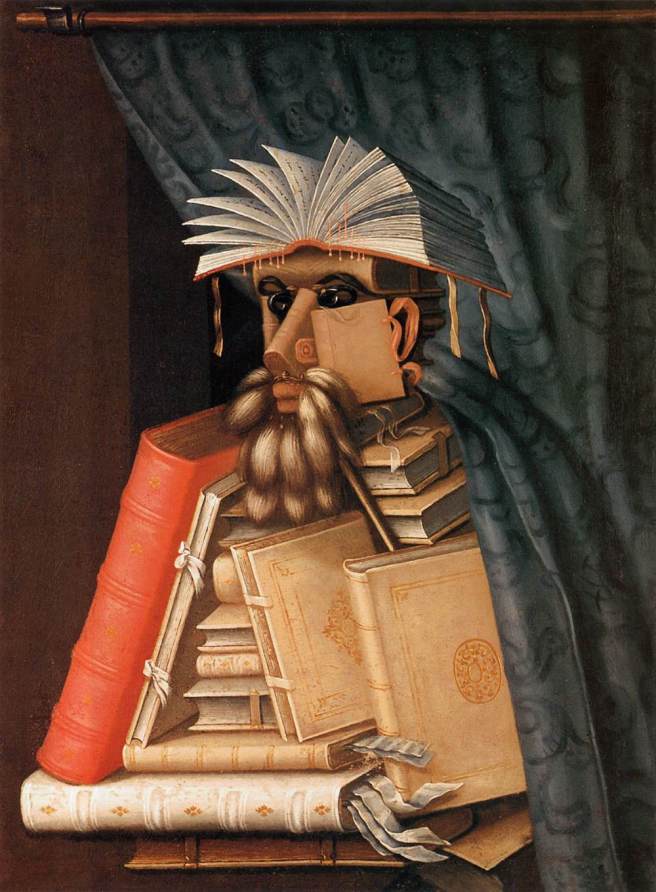
Guiseppe Arcimboldo is a hazy peripheral figure in art history. Enjoying noble and royal patronage he was honoured during his lifetime before completely falling out of fashion during the 17th, 18th and 19th Centuries only to be rediscovered by the Surrealists in the 20th. Salvador Dali, Rene Magritte and Man Ray were all admirers and Arcimboldo’s visual puns and double meanings undoubtedly influenced Dali’s infamous paranoiac-critical method. Other art historians posited Arcimboldo as the most mannered of all the Mannerists. His composite portraits certainly show the period’s taste for enigmas and riddles taken far into the hinterlands of the grotesque and the whimsically bizarre.
Vertumnus is Arcimboldo’s most famous painting, a composite portrait of his patron, Holy Roman Emperor and King of Bohemia Rudolf II as Vertumnus, the Roman God of metamorphosis, the seasons, gardens and vegetable growth. The plants, flowers and fruits that form the portrait of Rudolf II are from every season and are taken to represent the perfect harmony and balance with nature that his reign would re-establish. Unfortunately events and history had other things in mind for the studious, occult inclined Rudolf II and his notably tolerant court of Prague, leading eventually to the calamity of the Thirty Year War between competing Catholic and Protestant states before engulfing the majority of European great powers.
Other notable composite portraits painted by Arcimboldo include the Four Seasons, the Four Elements and the witty The Librarian (below).


Wow! The painting was a stunning introduction to Arcimbundo.
LikeLiked by 1 person
*Arcimbuldo. Sorry the autocorrect is a little hasty. 😁
LikeLiked by 1 person
Don’t worry it happens to me all the time!😊
LikeLiked by 1 person
Thank you, definitely a fascinating oddity.
LikeLiked by 1 person
I particularly love the “Librarian”. A lover of books composed of books. Beautiful.
LikeLiked by 1 person
Thank you Miss Heart. Yes the librarian is beautiful and very witty. Glad you enjoyed.
LikeLiked by 1 person
I find it astonishing that art that looks this surreal should be half a millennium old
LikeLiked by 1 person
It is quite amazing. Prague at the time was way ahead of the curve, but unfortunately it wasn’t to last. Thanks for the comment Kestrel.
LikeLiked by 1 person
Interesting stuff! I really love the one with the books 🙂
LikeLiked by 2 people
Thank you Christine…all of us is who love books
LikeLiked by 1 person
Actually I like this accidental wording too
LikeLiked by 1 person
Sometimes it makes more sense than what I actually write. Thanks Kestrel.
LikeLike
Sorry Christine I meant to say all of us who love books would find this painting endearing.
LikeLiked by 2 people
Sorry Christine… I meant to say all of us who love books would find this painting endearing.
LikeLiked by 1 person
How very unique. I agree with the others about the Librarian, wonderful!
LikeLiked by 1 person
Thank you Lily. That is why I included it because it seemed apt.
LikeLiked by 1 person
The librarian seems oddly modern if you wouldn’t know who painted it and when!
LikeLiked by 1 person
Agreed rather odd that. Glad you enjoyed this odd little post.
LikeLiked by 1 person
Interesting. Not familiar with the artist, so thank you for bringing him to my attention.
Namasté
नमस्ते
Chazz Vincent
LikeLiked by 1 person